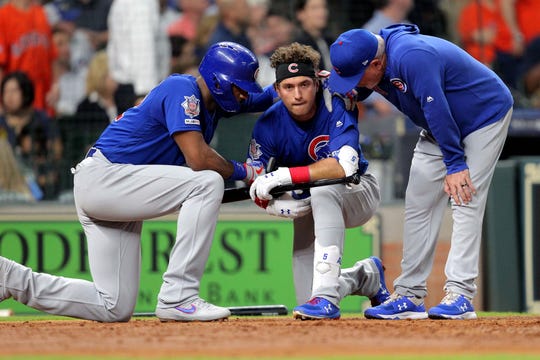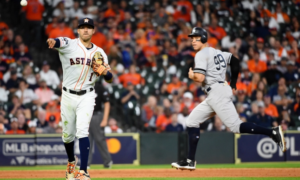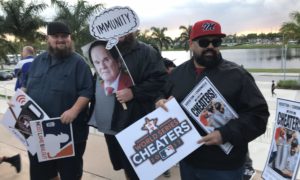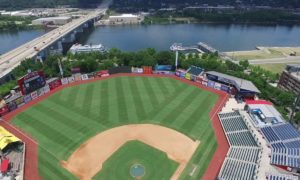Almora Foul Ball Renews Protective Netting Debate


For a parent bringing his or her child to an MLB ballpark, nothing could be worse than that child getting struck with a baseball or bat. On Wednesday, May 29, during the fourth inning of the Cubs-Astros game in Minute Maid Park, that’s exactly what happened.
Albert Almora Jr. hit a foul ball into the stands past the visiting dugout along the third-base line, striking a young girl. The girl, crying, was taken away and brought to a hospital. Teammates and stadium staff consoled Almora, for his part, visibly upset after the incident.
Scenes like this bring the issue of fan safety and the use of protective netting back into the forefront for Major League Baseball. Not unlike the addition of pitch clocks, netting is likely an unwelcome focus for an organization intent on growing interest in the game among young people while still preserving the sense of tradition associated with the sport.
At first blush, framing the issue of spectator safeguards as a “debate” seems like equivocation. After all, who wants to get hit in the head by a foul ball or errant shard of a baseball bat? More safety is a good thing, right? The thing is: it depends who you ask. A problem arises when attendees who pay good money for seats don’t want to watch the action from behind netting or don’t wish to be denied the chance to catch a foul ball.
This dovetails with the probable view held by some purists that you simply need to be alert during the game. Foul balls are a part of baseball! That’s why you bring your glove to the ballpark! Along these lines, the legal principle of “assumption of risk” tends to govern professional sporting events like baseball games. Depending on where you sit, you are liable to have a baseball or other debris come your way. Maybe you shouldn’t be bringing your young son or daughter to the park.
Perhaps. But maybe the outmoded “assumption of risk” doctrine fails to account for just how dangerous the game of baseball can be. Baseball has changed markedly since its inception, as with the other major sports. Players are stronger and faster. Pitchers throw harder and harder. Batters also hit the ball harder and harder the other way.
As pitchers over the years struck by comebackers can attest to, reacting to a baseball hit directly at you isn’t that easy. Search the Internet for “pitchers hit by line drives” and you’ll get a bevy of results linking to stories about pitchers struck by batted balls and their ensuing injuries. Concussions. Bruised jaws. Broken arms and noses. The list goes on.
These are trained athletes, most of them in their 20s and 30s. If they can’t react to balls with an exit velocity of 100+ MPH, what chance does the average fan have? Especially if he or she is a younger fan and/or is on a mobile device and is distracted to begin with. Again, there is an assumption of risk, but with smart phones and other devices so accessible, it’s surprising that there aren’t more incidents like the one described at the start of this piece.
As Almora, the player directly impacted by his part in the accident, believes, Major League Baseball should do “whatever [it] has to do to make that happen.” He’s not alone in that assertion on the Chicago Cubs. In Kris Bryant’s view, the league needs to extend netting even further down the lines. Jason Heyward also reportedly has expressed support for expansion of protective netting around the stadium in foul territory.
When it comes down to it, though, it’s hard to have much confidence that baseball will do anything substantive to address fan safety, even in the wake of this incident. Phil Rosenthal and Tim Bannon of the Chicago Tribune, breaking down the use of protective netting in MLB stadiums in a mock Q-and-A session, note how this “long-simmering issue heated to a boil” when a young child hit by a Todd Frazier foul ball in 2017 suffered bleeding on the brain. Consequently, commissioner Rob Manfred asked teams to add netting and they obliged.
The extent of the child’s injuries in this latest episode are unknown. Still, it’s fair to wonder whether MLB teams and the league are doing enough to protect fans by requiring the use of protective netting. For one, on-field foul territory has been on a steady decline in recent years, related to stadiums adding seats closer to the field of play. Moreover, as Rosenthal and Bannon underscore, some stadiums (like Wrigley Field) are content to meet the minimum league requirements and nothing more. By contrast, in Japan, stadiums employ pole-to-pole coverage of foul territory using protective netting and ushers sound whistles and horns when balls clear the netting to alert fans.
To some, this might sound like overkill. The counterargument, however, is that Major League Baseball can’t put a price on spectator safety. Whether you’re in the stands or on the diamond, you don’t want to worry about someone getting seriously injured or worse as a result of a stray batted ball. In August 2018, a woman died of a brain hemorrhage days after getting struck in the head by a foul ball in Dodger Stadium. As her daughter, Jana Brody, told ESPN, “it’s unconscionable that fans are still getting hurt by hard-hit foul balls and MLB has not increased the netting requirements.” The goodwill gained from reducing fan injuries is worth more than concerns about the additional cost of expanding protective netting or any hindrance it would represent to seeing the action on the field, both of which are realistically minimal.
Rather than framing visitor safety as a matter of choice, Commissioner Manfred and the league should do more than throw up their hands and point to bare minimums for protective netting. Their defense of MLB’s actions up to now rings as hollow as repeated deflections about gun control in American politics. Sooner or later, someone else is going to get badly hurt unless this situation improves. It’s up to the league and team owners to act on behalf a sport that is clearly behind the curve.


















